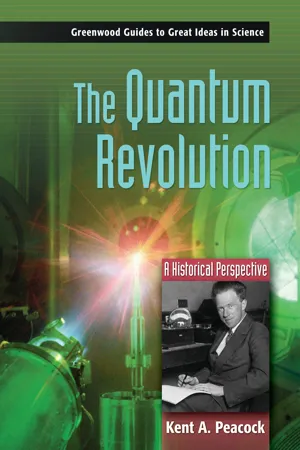
- 240 pages
- English
- PDF
- Available on iOS & Android
About This Book
Quantum mechanics is one of the great success stories of modern physics, making sense of the very small just as Einstein's theory of relativity made sense of the very large. But, for most students, the ideas that make quantum mechanics powerful can be confusing and counterintuitive. This volume in the Greenwood Guides to Great Ideas in Science series provides a history of quantum mechanics from the early breakthroughs of Planck and Einstein, at the beginning of the 20th century, to the present frontiers of quantum computing and quantum gravity. The approach is entirely non-technical, and is aimed at the general reader who may not have much mathematical background but who has a strong curiosity about some of the most important developments in modern science. Quantum Mechanics: A Historical Perspective traces the history of this powerful theory, including:
; The early discoveries by Max Planck and Albert Einstein regarding the quantization of radiation
; The early quantum theory, including Neils Bohr's theory of the atom
; The birth of modern quantum mechanics through the work of Heisenberg, Schrodinger, Born, Dirac and others
; Applications of quantum mechanics in chemistry, nuclear physics, electronics, and many other areas
; Recent work in quantum computation and quantum information theory
The book emphasizes the fact that despite the great success of quantum mechanics, many exciting intellectual frontiers remain open for further researchers to explore. It includes a glossary, a timeline, and a bibliography of accessible resources for further research.
Frequently asked questions
Information
Table of contents
- Contents
- List of Illustrations
- Series Foreword
- Preface
- Acknowledgments
- Introduction: Why Learn the History of Quantum Mechanics?
- 1 The Twilight of Certainty
- 2 Einstein and Light
- 3 The Bohr Atom and Old Quantum Theory
- 4 Uncertain Synthesis
- 5 Dualities
- 6 Elements of Physical Reality
- 7 Creation and Annihilation
- 8 Quantum Mechanics Goes to Work
- 9 Symmetries and Resonances
- 10 “The Most Profound Discovery of Science”
- 11 Bits, Qubits, and the Ultimate Computer
- 12 Unfinished Business
- Timeline
- Glossary
- Further Reading
- References
- Index
- Illustration 1.1 Max Planck.
- Illustration 1.2 Light Waves.
- Illustration 1.3 The Electromagnetic Spectrum.
- Illustration 1.4 Planck’s Law.
- Illustration 2.1 Fluctuations and Brownian Motion.
- Illustration 2.2 Spacetime According to Minkowski.
- Illustration 3.1 Spectral Lines.
- Illustration 3.2 Niels Bohr.
- Illustration 3.3 Energy Levels in the Bohr Atom.
- Illustration 4.1 Werner Heisenberg.
- Illustration 4.2 Erwin Schrödinger.
- Illustration 4.3 Typical Electron Orbitals.
- Illustration 4.4 Heisenberg’s Microscope.
- Illustration 5.1 Paul Dirac.
- Illustration 5.2 The Dirac Sea.
- Illustration 5.3 The Double Slit Experiment.
- Illustration 6.1 Niels Bohr and Albert Einstein.
- Illustration 6.2 Schrödinger’s Cat.
- Illustration 6.3 The EPR Apparatus.
- Illustration 7.1 Feynman Diagrams.
- Illustration 7.2 There Is Only One Electron in the Universe!
- Illustration 7.3 Richard P. Feynman.
- Illustration 8.1 Barrier Penetration.
- Illustration 8.2 Lise Meitner.
- Illustration 8.3 The Laser.
- Illustration 9.1 Typical Bubble Chamber Tracks.
- Illustration 9.2 Table of “Elementary” Particles in the Standard Model.
- Illustration 10.1 David Bohm.
- Illustration 10.2 John S. Bell.
- Illustration 10.3 The Aspect Experiment.
- Illustration 10.4 Bob Phones Alice on the Bell Telephone.
- Illustration 11.1 Classical Turing Machine.
- Illustration 11.2 Quantum Turing Machine.
- Illustration 11.3 Quantum Teleportation.
- Illustration 12.1 The Hawking Effect.
- Illustration 12.2 The Unruh Effect.
- Illustration 12.3 Stephen Hawking.